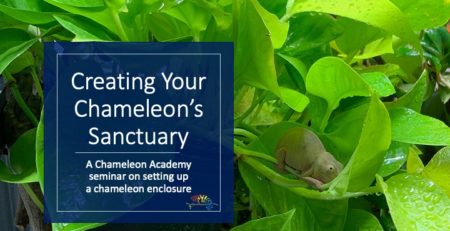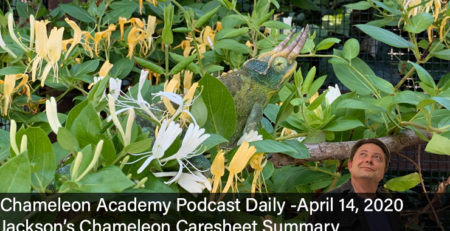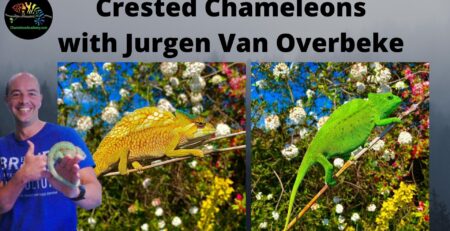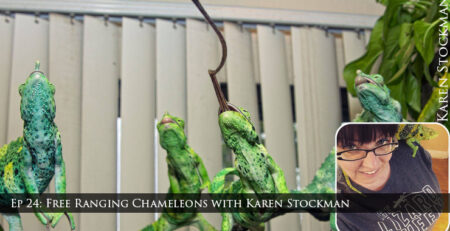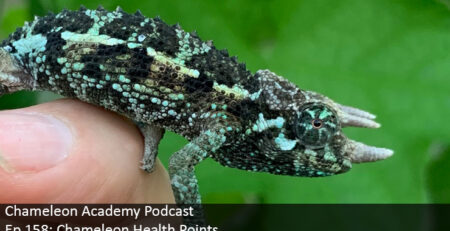Making a New Chameleon Species Care Guide
How are Chameleon Academy care guides put together? It is usually based on the experiences of a number of serior members of the chameleon community. This episode gives a behind the scenes look at the creation of a care guide for Calumma brevicorne, the Short-Horned Chameleon!
Embedded Podcast Player
See the final result here!
This episode talks about putting together a chameleon species care guide for Calumma brevicorne. At the Chameleon Academy this is a major undertaking as it comes with a multipage care guide and a webpage with detailed descriptions. You can see the end result of the care guide and profile page by clicking on the image below!
Podcast Transcript (more or less)
Good morning Chameleon Wranglers! Today I have the pleasure of talking about a certain interesting species of chameleon that flies under the notice radar. I am releasing a care guide for the species Calumma brevicorne, or the Short-Horned Chameleon. But more than just another species profile, I want to bring you behind the scenes to show you the various hoops we have to jump through to create a care guide for a species we are just figuring out. While, yes, you expect someone who creates a care guide to have actually kept the chameleon species and gone through at least one full lifecycle of adult care, reproduction, and raising the babies to adulthood, there are times, like now, that we need a care guide to help other people get involved with this species so we can establish a community! And to do this I am adding my experience with brevicorne with two other keepers and amongst all of us we have experience keeping brevicorne indoors, outdoors, seeing them in the wild, mating them, incubating eggs, and hatching babies. So, by combining the first hand experiences and input from six different sources we are going to establish a baseline and let that be a foundation from which a community can build.
So, yes, in this episode you will learn the basics of care for this chameleon, but you will also be given a front row set to how we start a micro-community dedicated to a specific chameleon species. It may even be entertaining if you are the sort that thinks chameleon taxonomical confusion is giggle worthy. Education… entertainment..what more could you ask from a chameleon podcast? Now that I have your appetites whetted for a thrilling ride, I’ll introduce you to the star of our show.
Enter, Calumma brevicorne. A mid-sized, cryptically colored chameleon with patterns of brown, tan and gray from Madagascar. Its most prominent feature is the large occipital lobes that extend behind the skull that can be flapped like large elephant ears to scare away rivals or impress females. This is a dramatic display and has earned then the alternative common name of elephant-eared chameleon. But common names tend to be many and confusing. I mean, wasn’t the Meller’s chameleon from main land Africa called the Elephant -Eared Chameleon in the 70s? We can’t just be trading names around like Pokemon cards. So the best way identify this species is Calumma brevicorne. You can’t go wrong with that…or can you?
Yes, my friend, we aren’t even two steps into the description of this chameleon when we are faced with family drama that drives us crazy. “Brevicorne” is not only a species name. It is the name of an entire complex of occipital lobe flapping chameleons. Calumma Malthe, Calumma crypticum, calumma amber, cucullatum, and so on. The problem is that some of these look quite similar in appearance – especially when younger. And this isn’t a big deal. When asked to ID an individual, taxonomists will ask where it is from and then let you know what it is. But this is not always possible when the chameleons are exported. The collection location is unreliable as there may have been a number of collection locations and the note taking in the field is not that good. Is this the kind of edge-of-your-seat drama you come to this podcast for? Why, yes it is. Because this means people receiving brevicorne may or may not be getting that species. And people trying to breed brevicorne may or may not have a pair of the same species.
A hush settles across the crowd….a child mournfully sobs.
So, yes, there have been significant challenges in establishing this species. I am part of a group called The Chameleon Enthusiasts on Facebook that includes Dr. Mark Scherz, a Madagascar field scientist and Dr. Chris Anderson, an actual chameleon studying scientist. And when other members of our group were trying to establish brevicorne breeding groups there were many rounds of trying to verify which species they actually had. Identifying sub-adults from images was challenging. Now, images combined with location data made it immensely easy. When I was in Madagascar I was in constant communication with Dr. Scherz and when I sent a picture along with latitude and longitude the ID was swiftly determined. And, it doesn’t hurt to have someone who studies the herpetofauna of Madagascar on your side. Those of you who get frustrated with the brevicorne complex, just wait until you try and sort out the nasutum complex! Holy moley, certain countries in the world would require an explicit label on this podcast if I went into detail on how you tell some of those apart! For those who have listen to previous episodes with Mark Scherz you know what I am talking about. For those who haven’t, I shall leave that for the strong in constitution to search and discover.
Welcome to the life of a chameleon nerd.
But, in all seriousness, when you are a breeder who is starting a breeding project you have to know what you are working with. I have been throwing around some species names that many people haven’t heard of before so this may seem like a problem that affects 1% of the most obsessed in the chameleon keeping community (pleased to meet you, by the way), but it is actually a wide spread problem. With all the different locales of panther chameleons the females look alike. A huge reason why breeding panther chameleons is much more of an investment than it seems is that you first have to figure out what locale your females are. Trusting what was written on the export container is a sure way to muddy up the genetics. Unfortunately, you can’t know a female’s locale until she has babies and you grow up a male. This is a process that can take 18 to 24 months. So this is a mainstream challenge! Recent possibilities in genetic testing show promise as to cut this process short. But the whole thing is made easier by having access to established and reputable breeders who have already gone through this process. You can trust that an Ambilobe is an Ambilobe from a breeder who has tenaciously proved out every member of their breeding group. But when you decide you want fresh bloodlines, well, don’t cut corners. I remember a situation where a breeder relied on incorrect information, started selling baby panther chameleons from that pairing and no one realized that this pairing was actually a mixed pairing. The babies were widespread and a number of breeders had done pairings themselves before the truth surfaced. Because of the time it takes to grow up a male and how some males will show the coloration you expect, you have to have information from more males of the clutch before making an ID. And of course, the females cannot be told apart and so matings done with them and babies sold from that mating now has to be tracked down. And you could have smudged the reputation of the breeders who trusted you so it is a domino damage effect. Not pretty. You may not have realized how important trust and due diligence is in the panther chameleon breeding community. So, this situation of chameleon ID is actually common in all corners of the chameleon keeping world. While you slept soundly in your beds, chameleon breeders have been anguishing over lineages. Let’s make sure we appreciate those unsung heroes.
But back to our chameleon of the hour, not only do you have to identify what species you actually have you have to figure out what conditions they like. Temperature data from the area is a good start, but you have to go way beyond that. Just relying on temperature data is dangerous because it is important to ask how the data was taken. A weather station is not going to replicate all the microclimates a chameleon inhabits. C. brevicorne likes dense forests and Madagascar is like any other forest. The denser the forest, the cooler it is inside. So the temperature on the outside in the sun could be creeping into the upper 80s and the branches inside the forest could be in the upper 70s. And since the chameleon can go up, down and to the forest’s edge, they can pop into the sun, warm up, and then hide in the deep shade during the afternoon. So the weather data would deceive you into giving much higher temperatures. Data is good, but we need to understand how to use it or else it will mislead. There is nothing that can replace being there in person and getting context. I was there earlier his year and was able to just “be” in the space where the chameleons were and brevicorne was one of those that liked dense forest, but would have access to the edge of the forest. And, this is common in chameleon species and the reason why understanding gradients makes figuring out the comfort conditions much easier. Put a heat lamp in the back left corner at 85F and the bottom right checks in at 72F and with a good network of branches and plants in between and your chameleon has a wide range of choices. By monitoring the behavior of your chameleon you can refine what conditions you give. For example, a panther chameleon will happily bask while a Trioceros cristatus will avoid the upper reaches of the cage where the lights are. Both cristatus and Calumma Oshaughnessyii will avoid UVB exposure while the Jackson’s Chameleon will search out the UVB. And this is the magic of having cages large enough that we can create enough microclimates that the chameleons have a choice of environments and take care of themselves. For all the effort we put into figuring out the ideal conditions for all the different species of chameleons you might notice that the cages I recommend for the chameleons in my care guides look strangely similar. And that is because if you create a cage that has an open top nine or so inches with a basking bulb in one corner and UVB available…and the middle two feet of cage space is densely planted to block out the light above then you find that Panthers, Veileds, Jackson’s, cristatus, oshaugnessyii, and, yes, brevicorne will do well. But each species will use the cage areas and microclimates differently. And this is why cage set-ups between the species look so similar. We are not forcing the same conditions on the different species. We are providing the same opportunities for the chameleon to use as they desire. The huge advantage is that we can use the forest edge cage set-up strategy for just about any species of chameleon even if we do not know their exact environmental requirements. And then we can go to that weather data and get an idea of the environmental extremes that are present. And this helps to fill in what the maximum and minimum temperatures and humidities might be. And, amongst the community of experienced chameleon keepers we can start helping each other by saying you can keep them like panthers or Jackson’s. Example, how may of you asking about the helmeted chameleon, Trioceros hoehnelii, are told to keep them like Jackson’s Chameleons? This is because there are care patterns amongst the species. And Calumma brevicorne…where does this chameleon fit in? Of course, this episode is not about the answer, but sharing with you how we sort through the data and observations to come up with care guide requirements. But, spoiler alert, if you asked Steve Hefner his closest approximation it would be to keep brevicorne like Jacksons with less basking. But we want to give brevicorne its own persona and so we will put together this care guide.
The reason this is relevant is that I had a request from Steve Hefner and Sean McNeeley to put together a Chameleon Academy care guide for Calumma brevicorne as they are working on establishing this species and needed a care guide to share with members of the Calumma brevicorne Keepers Facebook group. You will notice that there are relatively few care guides on the Chameleon Academy website and that is because they are so detailed and I want the experience of a full lifecycle available to me before putting one together. For brevicorne I did not have this experience personally. I did keep and hatch out brevicorne in the early 2000s, but I did not keep the kind of notes that I would now. I am amazed at much I have grown over these years.
And, just as a side note, I’ll give you the secret to personal growth. It is being accountable to others. When your definition of success is being able to breed a certain species there are a number of things you may be doing that you don’t realize. There may be things you get lucky with because of the water quality in your area or fruits and vegetables available to you. Or seasonal environmental weather patterns that aid you. And we piggy back on these for our credentials. In fact, being the only one who is successful breeding this or that chameleon is often a bit of a bragging point. I am just that good. But that kind of expertise is haphazard. It is certainly not fake, but it is also not entirely earned. You really want to know you know what you are talking about? It is when you can help other people reproduce the same success. That is true expertise. And this is why my Chameleon Academy outreach takes so much energy and has been such a source for my personal growth. And this is why my care guides are constantly being scrutinized by me and updated. It can’t be just a record of what worked for me. It has to be a text book as to what will work for you. And this is why my care guides receive updates every couple years. Did the chameleon’s requirements change? No, but my understanding of the fine details have grown as I have received feedback from people around the world as to how they interpreted and executed what I put down. And every time they get back to me and explain that I add another facet of understanding to my personal growth – and then share with you all to refine it further. The care guides are updated and we as a community move forward another step. As far as I am concerned, expertise is not in what you can accomplish. It is when you can help other people have the same or even more success. That is how you tell the difference between luck and true understanding.
Would you like an example? How about raising chameleons with no multivitamin supplement powder. I just used UVB light with Arcadia EarthPro A every feeding. EarthPro A is essentially calcium to counteract high phosphorus crickets, bee pollen, and a raft of carotenoids. The UVB light is for D3 production. And then gut loaded feeder insects. By using this diet, which has zero preformed vitamin A, I was able to successfully raise healthy generations of chameleons. But you will notice that all my care guides recommend regular dustings of Repashy Calcium Plus LoD which has preformed vitamin A. This is because some people had vitamin A deficiencies. Now, why the different results? I don’t know. So me being able to raise chameleons without giving them preformed vitamin A in a powder was not expertise. It was luck. There was something I was doing that was benefiting me. But until I figured out what that thing is in the way that other people could reproduce the success, there was a part of my husbandry I didn’t understand. The most obvious place to look is in how I gut load my feeder insects. Was it the use of sweet potatoes? Maybe. But it isn’t always easy to figure out and it could be something not obvious. To this day, I still do not have an answer. And this is an example of the small steps of personal growth we go through when we help other people achieve our success. It points out what we do not yet know and drives us to figure those things out. And when I figure out how to help everyone raise chameleons without vitamin A deficiency, not just the majority, without powder supplements, I will have taken a personal step forward. So, for those of you out there who are so passionate about chameleons that the knowledge you develop is more important than the ooos and ahsss of people wishing they could do what you do, get into teaching. It will be harder, but every level you lay down will be a solid step up.
So, anyway, how do we start to put together a care guide for a species that isn’t established so we can help people join the effort to establish it? Well, you bring together everyone’s experience and piece together a lifecycle! And that is what we did for the newly released Calumma brevicorne care guide.
Now, you hear about a lot of species here on the podcast. And it isn’t too hard to go to the Chameleon Academy dot com website and find the minutia of the care requirements. So, I will answer the questions not on the care guide.
Calumma brevicorne is a species with quota from Madagascar and so they are available each year in limited quantities. They are a species of least concern according to the IUCN Red List. Personality-wise they seem outgoing. Almost like panther chameleons. At least in my experience. You need more than one or two experiences to really be accurate in assessments so keep this in mind. They have long tails and the males will have a red horn when they are trying to impress females. In the past, the imports have sometimes been mixed in with Calumma crypticum which is a very similar looking species. The biggest challenge in establishing them is their incubation. There has been hatching success, but not enough that I would say we know what we are doing. Present opinion is that they need a diapause Which is a two month stay at 55F near the beginning of the incubation and then the rest of the incubation at the low 70s. The whole process lasts about 9 months after you bring them out of diapause. Gestation, meaning how long after mating the female lays eggs, has been tricky to nail down. I have seen reports of 40 and 44 days pop up on the internet, but Steve Hefner’s C.brevicorne is going on 60 days. Calumma tend to have longer gestations so this is not a concern. But this information will have to be firmed up. With a handful of people working with hatchlings and eggs we should be getting better lifecycle information in the next year or so. I am incubating a few eggs myself and look forward to being able to nail down both age of sexual maturity and gestation. We also will hopefully start to have reliable hatchlings. I don’t know that C. brevicorne will ever have mass appeal. Though, it is a fascinating species and I am excited to be able to work with it again. If you are interested in working with brevicorne then find the Calumma brevicorne Keepers group on Facebook and start being part of the community. I don’t know where this will lead. And I have been around long enough to know we don’t have to have a master plan.
And for those of you wanting a quick husbandry review, They do well in a 2x2x4’ cage or bigger that is well planted. Give them mid 70s ambient temperature and a 80F basking spot. Standard UVI = 3 at the basking branch, whether they use it or not. Use the naturalistic hydration method with fogging during the early morning hours. They come from Madagascar which has a wet and a cooler dry season. On the care guide I have listed a suggestion as to how to create a wet and dry season distinction without including the deadly stress of the dry season.
So, this is the first step. I look forward to the C. brevicorne community giving feedback and allowing me to record all the experiences in future iterations of this care guide. This provides a central location to collect the knowledge we will build.
And if you have the desire to work with a species which may not have a care guide or care parameters, then remember that a general idea of their natural environment, a large enough cage with many microclimates, and keen observation on your part can get you through to figure things out! Once you see the patterns you realize that tweaking them for the different species isn’t always that hard.
My name is Bill Strand and I produce the Chameleon Academy educational outreach. I also have weekly live sessions that are interactive and you can come with questions and comments. There is one on Instagram on Tuesday nights at 5PM Pacific and Chameleon & Coffee on YouTube on Saturdays at 12 Noon Pacific. If you have questions I invite you to join one of these live sessions. Or just come and hang out and listen to all the banter! It is fun to just be part of it!
Thank you for joining me here. It has been a blast. And I will see you next time!




